The Agent’s Role as Advisor and Risk Manager
Editor’s note: This is the second of a three-part series to explain insurers’ requirements for building updates and to help agents advise clients on mitigating risks inherent in older buildings. The first article addressed aging electrical systems and appeared in the Feb. 25 edition of Insurance Journal. The final installment will offer advice for HVAC and roofing systems.
The older a building, the more likely it is to have serious defects, particularly in critical building systems such as electrical, plumbing, HVAC and roofing. Older buildings generate more claims than younger properties, especially if they have not been well-maintained or if their building systems have not been updated.
This is why an insurer will ask a policyholder about the age of the original building, the age of renovations or additions and the age and condition of critical building systems. The information helps the insurer price the coverage fairly, and brings to light any serious defects to be corrected. In the case of serious plumbing defects, failure-prone polybutylene piping for example, or when a major update is needed, say, an aging water heater, the insurer may request the upgrades as a condition of coverage.
If the property is more than 30 years old, expect the insurance underwriter to ask the agent:
- What type of water supply piping is present in each part of the building? Copper, galvanized, polybutylene or other?
- When was this installed? What is its condition?
- Has the piping been updated in any part of the building? When was this done? Describe what updates were made. Were they full, or partial?.
- Have there been any problems or failures of the plumbing system? If so, describe the problem and how it was addressed.
- If the property has laundry facilities, when were the laundry hoses last replaced? What types of hoses are in use? Are they standard black hose, braided steel or heavy duty rubber?
- When was the water heater installed? What is its condition? Has it been installed and vented if appropriate to do so, according to the manufacturer’s specifications? Is it properly braced to protect against seismic activity?
- What type of fuel is used in the water heater? Natural gas, electric, oil, other?
- How is maintenance of the water heater handled?
- Are the drain and waste piping made from cast iron, vitrified clay (VC), or other material?
- How is maintenance of the plumbing system handled?
Plumbing systems typically require updating only on as “as-needed” basis, such as when components fail due to age or inadequate maintenance, or when the discovery of material weaknesses or failures during inspections warrants repairs and replacements.
Piping
It is important to be aware of the type of piping used throughout the property, as various types present unique challenges as they age.
Polybutylene piping, which is relatively inexpensive and easy to install, was installed in millions of buildings from the 1970s to the 1990s (See Figure 1). The material turned out to be inappropriate for use in plumbing systems, however, because standard water treatment chemicals, such as chlorine and anti-bacterials, cause it to become brittle and subject to cracking and breakage. The degradation of the pipe can also affect the water quality, as chemicals leach into the water. Polybutylene pipe must always be replaced. It has proven unreliable and will eventually fail. It cannot be repaired. Polybutylene pipes are no longer recognized by building codes in the United States and Canada.
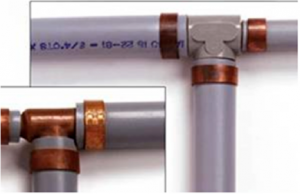
Failure of metal piping systems is generally caused by erosion, corrosion or a combination of the two. Erosion occurs to some degree in every metal piping system. The friction of water flowing within a pipe erodes the metal, gradually wearing it away. In lines where the flow is rapid and/or frequent, such as in recirculation lines, the pipe walls will erode relatively quickly. Corrosion, in which the metal piping reacts chemically with the water, is a bigger problem. The rate of corrosion and the way in which it affects the pipe varies depending on the types of metal used, the chemistry of the local water supply and the temperature of the water. Corroded pipe is more vulnerable to bursting in below-freezing temperatures.
Galvanized iron piping – steel pipe covered with a protective layer of zinc – was installed in many structures built before 1960; it generally does not last more than 25 years. Over years of use, the zinc coating erodes, causing a build-up of corrosion within the pipe. This can reduce or completely block the flow of water, increasing the risk for leaks. The internal corrosion also affects the water quality, as lead and other metals leach into the water, causing discoloration and an unpleasant taste. Figures 2 and 3 show corrosion on the outside of the pipe, a sign of system-wide problems. The problem can be corrected by installing new piping alongside the old galvanized pipe, or by having the old galvanized pipe cleaned out and treated with a protective epoxy lining.
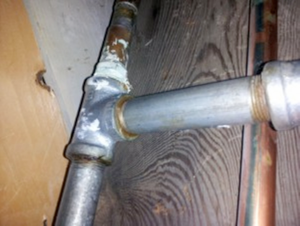
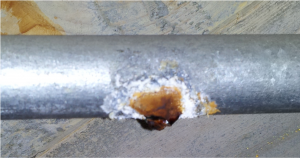
Other types of pipe that are subject to corrosion – including steel piping, older cast iron drain and waste piping, and older copper piping – should be scheduled for replacement before problems develop.
Piping presents a significant challenge. Because it is largely concealed – hidden behind walls or beneath concrete slabs – it is generally ignored until a failure occurs. In buildings where piping is accessible, such as in crawl spaces or basements, it can be inspected for signs of wear and deterioration so that repairs can be made in a timely manner, before any loss occurs. Building owners whose properties have inaccessible or outdated and plumbing systems should engage licensed plumbing professionals who have the technology to assess the condition and wear of the piping, such as by using a plumbing camera to capture digital video and images from inside the pipe. This process can identify the origins of any leaks, and bring to light other problems, such as corrosion or blockages, so that they can be repaired before a failure occurs.
Like piping, washing machine hoses and water heaters operate out of sight, and are generally ignored unless they fail. Washing machine hoses and water heaters have very short life spans, and are often responsible for the most costly water damage claims. Agents can provide a valuable service to their clients by encouraging them to maintain these carefully, and replace them before they fail.
Washing Machine Hoses
More than half the water damage claims related to washing machines were from broken water supply hoses. These incidents are also very costly, with the average claim running to more than $6,000.
Washing machine hoses break because of:
- Age. Over time, all washing machine hoses will wear out. A study from the Institute for Business and Home Safety showed that failure rates increased dramatically in hoses over five years old; the average age of failed hoses was 8.7 years. More than half of failures occurred before eight years, and nearly 80 percent failed before 10 years.
- Materials. Many washing machine hoses are made of reinforced rubber that loses resiliency as it ages, making it subject to cracks, leaks and bursting. (Figure 4)
- Installation Errors. Improper installation can damage the hose and hasten its failure. The most common installation error is failure to leave sufficient room to prevent kinks in the hose, particularly near the valve connections.
- Manufacturing Defects. Cracks, crimps or blockages in the line will cause premature failure.
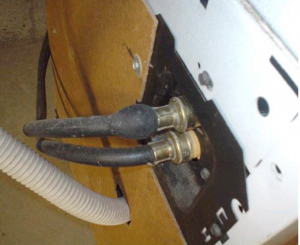
When hoses or connections are weak or faulty, the normal pressure of water in the system will break the hose or coupling, sending water flooding out. In a typical home, water will spill out of a single hose at a rate of about 650 gallons per hour.
There are good alternatives to the standard black rubber hose, as shown in Figure 5. Consider these three hose types as “good,” “better,” and “best” approaches to managing the risk of burst washing machine hoses.
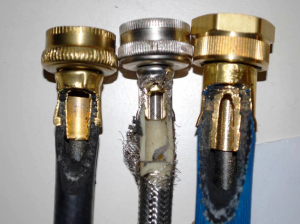
Water Heaters
Aging water heaters present another significant hazard. Every water heater will eventually fail, whether by slow leaking or by catastrophic failure – usually a crack or outright bursting, with total release of water.
As a water heater ages, corrosion and sediments accumulate inside the tank. In an older, poorly-maintained heater (Figure 6), the weakened tank is likely to split or burst under the constant pressure of the water within. The water in the tank, usually between40 and 80 gallons, will flood out immediately, followed by a continuous stream from the cold water feed, which will continue to flow until it is shut off. Even a slow leak can cause considerable damage, causing decay, mold, mildew, warping and eventual structural damage which can lead to collapse of subfloors and floors.
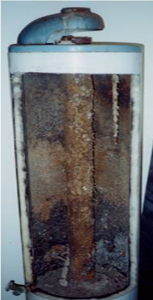
water heater.
An analysis by Sequoia Insurance shows that in commercial properties, damage from failed water heaters can run to half a million dollars or more, depending on the location of the water heater, the type of property and the extent of resulting damage.
A study by the Institute for Business and Home Safety found that water heater malfunctions, with an average cost of $4,400 per incident are one of the leading causes of water damage claims in residential properties. The IBHS review of 700 water heater insurance claims showed that leaking or burst tanks made up 69 percent of the failures.
The total cost of a failed heater, including repair of water damage, is far more than the cost of a scheduled replacement and installation. The flood that follows a failure can cause significant damage to furnishings and equipment as well as to the structure itself, requiring significant investment for cleanup, mold remediation, renovation and refurnishing.
Every water heater will eventually develop weaknesses and will need to be replaced. The useful lifespan of a typical water heater is five to ten years, depending on several factors, including the hardness of the water, the intensity of use, and the effectiveness of a preventive maintenance program. The IBHS study shows that the chance of leaking and failure rises steeply in water heaters that are more than five years old, and indicates that nearly three quarters of all heaters fail before they are 12 years old. Very few water heaters last longer than 10 to 12 years.
Unless a water heater is on an effective preventive maintenance program, a good risk management approach to this hazard is the replacement of any water heater when it reaches ten years of age.
By helping the policyholder to understand these “age of building” questions, and by assisting with gathering and communicating accurate information to the underwriter, the agent fosters a mutually beneficial relationship between the insurer and the policyholder. By serving as an informed advisor and advocate, the agent can help the policyholder to reduce risk, increase safety and save money over the long term.
Was this article valuable?
Here are more articles you may enjoy.


 Progressive Records Five-Fold Increase in Q1 Net Income
Progressive Records Five-Fold Increase in Q1 Net Income  Coral Gables, Florida Tops Beverly Hills as Ritziest Home Market in US
Coral Gables, Florida Tops Beverly Hills as Ritziest Home Market in US  AIG Sues Newly Launched Dellwood Insurance and Its Founders
AIG Sues Newly Launched Dellwood Insurance and Its Founders  Former MLB Player, 3 Others Charged with Staging Auto Accident in Miami
Former MLB Player, 3 Others Charged with Staging Auto Accident in Miami 


